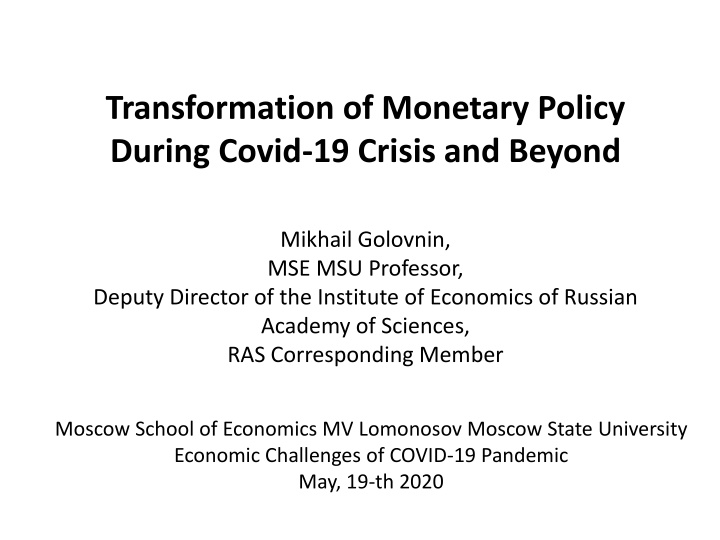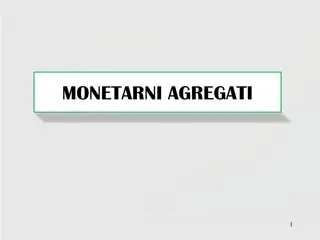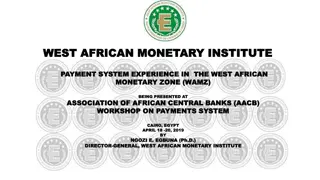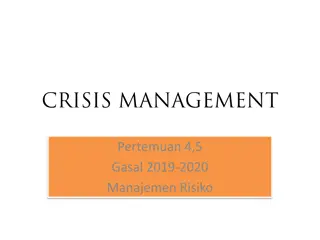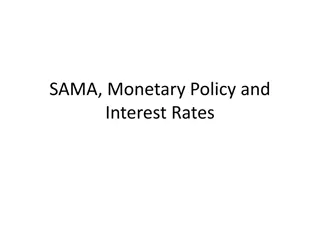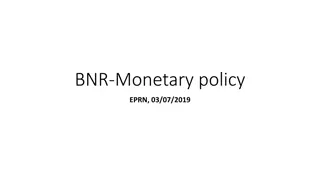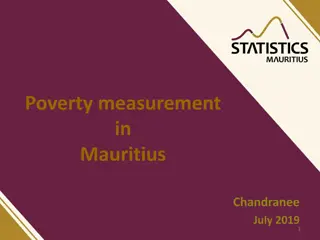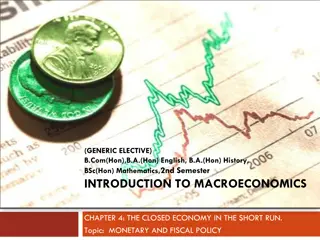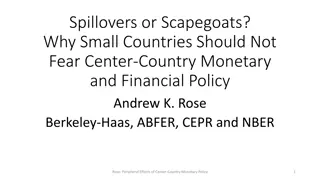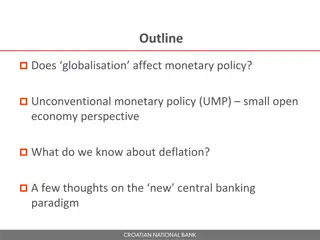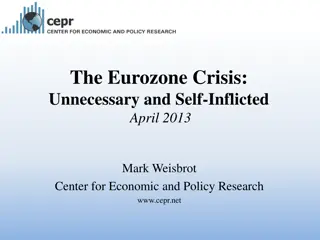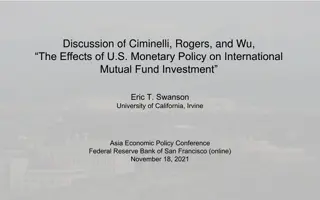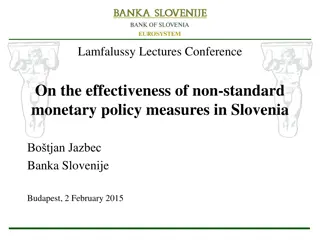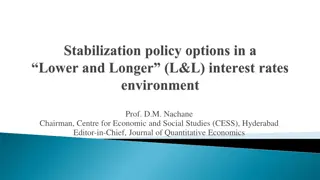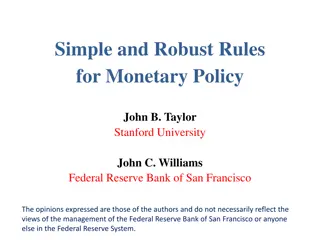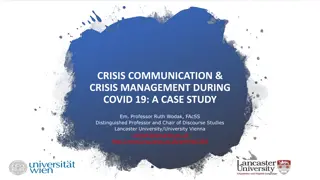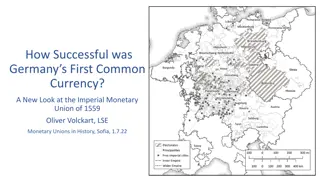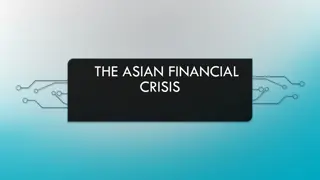Transformation of Monetary Policy During Covid-19 Crisis and Beyond
The transformation of monetary policy during the COVID-19 crisis and beyond, focusing on unconventional monetary policy practices in advanced economies, special measures introduced by the FRS, quantitative easing programs in the US, Euro Area, and Japan, and changes in monetary policies in emerging market economies, including the rise of countries with inflation targeting frameworks.
Download Presentation

Please find below an Image/Link to download the presentation.
The content on the website is provided AS IS for your information and personal use only. It may not be sold, licensed, or shared on other websites without obtaining consent from the author.If you encounter any issues during the download, it is possible that the publisher has removed the file from their server.
You are allowed to download the files provided on this website for personal or commercial use, subject to the condition that they are used lawfully. All files are the property of their respective owners.
The content on the website is provided AS IS for your information and personal use only. It may not be sold, licensed, or shared on other websites without obtaining consent from the author.
E N D
Presentation Transcript
Transformation of Monetary Policy During Covid-19 Crisis and Beyond Mikhail Golovnin, MSE MSU Professor, Deputy Director of the Institute of Economics of Russian Academy of Sciences, RAS Corresponding Member Moscow School of Economics MV Lomonosov Moscow State University Economic Challenges of COVID-19 Pandemic May, 19-th 2020
Transformation of monetary policy in advanced economies started during global economic crisis Unconventional monetary policy practices: - US from 2008 to 2014. - ECB elements from 2010. Zero MRO interest rates from March 2016. - Japan started from 2001, then renewed after the crisis. Main directions of unconventional policies: - Aimed at selective financial markets and agents. - Aimed at economic recovery.
FRS special measures aimed at selective markets Money Market Investor Funding Facility Commercial Paper Funding Facility Primary Dealer Credit Facility Asset-Backed Commercial Paper Money Market Mutual Fund Liquidity Facility Term Securities Lending Facility Term Auction Facility Term Asset-Backed Securities Loan Facility These measures were introduced in 2008 and has been gradually expiring till end-June 2010.
Quantitative easing programs US - Three rounds of quantitative easing programs (ended at October 2014) - Maturity Extension Program Euro Area Asset purchase programs (started from mid-2014): - three covered bond purchase program (CBPP3) - asset-backed securities purchase program (ABSPP) - public sector purchase programe (PSPP) - corporate sector purchase program (CSPP) Japan - Quantitative monetary easing policy (2001-2006) - Comprehensive monetary easing(2010-2013) - Quantitative and Qualitative Monetary Easing (2013 - ). From 2016 it was supplemented with Yield Curve Control.
Changes in monetary policies in emerging market economies Rise of number of countries with inflation targeting frameworks. Emphasis on exchange rate regulation (either through foreign exchange interventions or through other instruments). Changing attitude to capital controls.
Monetary policy frameworks (IMF Annual Reports, 2009, 2019) Frameworks Number of countries April 2009 April 2019 Absence of independent monetary policy 23 24 Exchange rate targeting 86 89 Monetary targeting 25 23 Inflation targeting 29 41
Financial openness of large economies Gross cross-border capital flows (per cent of GDP) 45.0 160.0 40.0 140.0 35.0 120.0 30.0 100.0 25.0 80.0 20.0 60.0 15.0 40.0 10.0 20.0 5.0 0.0 0.0 2000 2002 2004 2006 2008 2010 2012 2014 2016 2018 United States Euro Area Japan United Kingdom (right axis)
Economic growth forecast EU Comission forecast (May 2020) IMF Forecast (April 2020) 2019 2020 2021 2020 2021 World 2,9 -3,0 5,8 -3,5 5,2 United States 2,3 -5,9 4,7 -6,5 4,9 Euro Area 1,2 -7,5 4,7 -7,7 6,3 Japan 0,7 -5,2 3,0 -5,0 2,7 United Kingdom Emerging market and developing economies 1,4 -6,5 4,0 -8,3 6,0 3,7 -1,1 6,6 China 6,1 1,2 9,2 1,0 7,8 India 4,2 1,9 7,4 Russia 1,3 -5,5 3,5
Inflation forecast (IMF WEO April 2020) 2019 2020 2021 World 3,6 3,0 3,3 United States 1,8 0,6 2,2 Euro Area 1,2 0,2 1,0 Japan 0,5 0,2 0,4 United Kingdom Emerging market and developing economies 1,8 1,2 1,5 5,0 4,6 4,5 China 2,9 3,0 2,6 India 4,5 3,3 3,6 Russia 4,5 3,1 3,0
Monetary policy reaction to covid-19 crisis in USA Rather quick rate cut to zero level in March 2020. Forward guidance. Rates will remain low until it is confident that the economy has weathered recent events and is on track to achieve its maximum employment and price stability goals. From March 26, 2020 Fed reduced reserve requirement ratios to zero percent. Discount window decrease of interest rate to 0.25 per cent and extending the terms to 90 days. Introduction of new (old) unconventional programs. - Financial sector support. - Business support. - Household and consumption support. - Public borrowing support. Fed entered again international swap lines (Cheng et al., 2020).
Federal funds rate (https://www.federalreserve.gov/monetarypolicy/openmarket.htm) Date Increase Decrease Level (%) 2020, March 16 0 100 0-0.25 2020, March 3 0 50 1.00-1.25 2019, October 31 0 25 1.50-1.75 2019, September 19 0 25 1.75-2.00 2019, August 1 0 25 2.00-2.25 2018, December 20 25 0 2.25-2.50 2018, September 27 25 0 2.00-2.25 2018, June 14 25 0 1.75-2.00 2018, March 22 25 0 1.50-1.75
Unconventional monetary programs of the FRS Term Deposit Facility Commercial Paper Funding Facility Primary Dealer Credit Facility Money Market Mutual Fund Liquidity Facility Primary Market Corporate Credit Facility Secondary Market Corporate Credit Facility Term Asset-Backed Securities Loan Facility Paycheck Protection Program Liquidity Facility Municipal Liquidity Facility Main Street Lending Program
Monetary policy reaction in euro area ECB decided to further ease the conditions on the targeted longer-term refinancing operations (TLTRO III) and to launch a new series of non-targeted pandemic emergency longer-term refinancing operations (PELTROs). ECB continues the set of asset purchasing programs. It introduced additional program - pandemic emergency purchase program (PEPP). During March-April 2020 cumulative net purchases by ECB through this program amounted more than 118 bln euro. On 7 April 2020 the ECB Governing Council decided to temporarily allow an extension of the additional credit claim frameworks with the possibility for national central banks to include loans backed by COVID-19-related public sector guarantees to corporates, SMEs, self-employed individuals, and households.
Monetary policy of emerging market economies (reaction to crisis) There is a room for rate cut (largest cuts in March-April 2020 were in Egypt, Turkey, South Africa, Pakistan). Exchange rate support through - Foreign exchange interventions (Brazil, Egypt, Indonesia etc.) or through forwards, swaps or repos (Brazil, Mexico, Peru). - Special CB instruments for providing FX liquidity (Brazil, Indonesia, Turkey etc.). - FX swaps with Federal Reserve (Korea, Singapore, Mexico has used the lines) (IIF, 2020).
Impact on emerging markets exchange rates NEER dynamics in some emerging markets in 2014-2020 (December 2013 = 100) 120 110 100 90 80 70 60 50 40 01-2014 03-2014 05-2014 07-2014 09-2014 11-2014 01-2015 03-2015 05-2015 07-2015 09-2015 11-2015 01-2016 03-2016 05-2016 07-2016 09-2016 11-2016 01-2017 03-2017 05-2017 07-2017 09-2017 11-2017 01-2018 03-2018 05-2018 07-2018 09-2018 11-2018 01-2019 03-2019 05-2019 07-2019 09-2019 11-2019 01-2020 03-2020 Russia China Brazil South Africa Indonesia Source: calculations based on BIS data (https://www.bis.org/statistics/eer.htm?m=6%7C381%7C676)
International liquidity (bln USD, end of period) 14000 12000 10000 8000 6000 4000 2000 0 1999 2000 2001 2002 2003 2004 2005 2006 2007 2008 2009 2010 2011 2012 2013 2014 2015 2016 2017 2018 2019 2020.03 International liquidity has stopped growing Source: International Monetary Fund (https://data.imf.org/regular.aspx?key=61545869).
Financial openness of Russian economy (calculations based on Balance of payments data) Cross-border gross capital flows in Russia (per cent of GDP) 40.0 35.0 30.0 25.0 20.0 15.0 10.0 5.0 0.0 gross capital flows with net errors and omissions gross capital flows with net errors and omissions and reserve assets' changes gross capital flows
Non-residents share in local government bonds issues (in per cent) 40 35 30 25 20 15 10 5 0
Monetary policy in Russia CBR states so called structural surplus of liquidity. Though there is a demand for liquidity providing mechanisms (mainly short-term repo operations). From mid-2019 CBR started the decreasing path of key policy rate. During covid-19 crisis the rate was cut once (April, 27-th) by 50 b.p. to 5.5 per cent. The rate is still positive in real terms. CBR implies credit easing policy (assessment of the quality of debt servicing, reduction of provisions for losses , transition to credit risk assessment based on internal ratings). CBR does not implement direct foreign exchange interventions or other exchange rate policy measures (foreign exchange swaps or repo operations).
Foreign exchange reserves in Russia (bln USD) (http://cbr.ru/hd_base/mrrf/mrrf_7d/?UniDbQuery.Posted=True&UniDbQuery.From=01.2017&U niDbQuery.To=05.2020) 600 550 500 450 400 350 300 06/01/2017 06/02/2017 06/03/2017 06/04/2017 06/05/2017 06/06/2017 06/07/2017 06/08/2017 06/09/2017 06/10/2017 06/11/2017 06/12/2017 06/01/2018 06/02/2018 06/03/2018 06/04/2018 06/05/2018 06/06/2018 06/07/2018 06/08/2018 06/09/2018 06/10/2018 06/11/2018 06/12/2018 06/01/2019 06/02/2019 06/03/2019 06/04/2019 06/05/2019 06/06/2019 06/07/2019 06/08/2019 06/09/2019 06/10/2019 06/11/2019 06/12/2019 06/01/2020 06/02/2020 06/03/2020 06/04/2020 06/05/2020
Monetary policy prospects in Russia CBR is focusing on 4 per cent inflation target. Though there may be upside risks for inflation from exchange rate changes. Risks for banking system from non-payments on credits will increase in the nearest months. There will be a need for recapitalization of the banking sector. Exchange rate policy should be implemented directly by the Central Bank, not through fiscal rule. Introduction of capital controls. It may help to increase room for maneuver for monetary policy.
Monetary policy prospects in the world Specific unconventional measures would be temporary, though asset purchasing programs will continue. Increasing interaction with fiscal policy. We enter again in the zero interest rates era. What should be with rising debts? There is a renewed need for macroprudential policies. It may partly help to manage debt burden. Probably it s time for cross-border capital flow regulations on global level.
References Cheng J., Skidmore D., Wessel D. What s the Fed doing in response to the COVID-19 crisis? What more could it do? Brookings Report. April 30-th, 2020(https://www.brookings.edu/research/fed- response-to-covid19/). Macro Notes COVID-19 Policy response in Emerging Markets. Institute of International Finance. April 15-th, 2020 (https://www.iif.com/Publications/ID/3845/Macr o-Notes-COVID-19-Policy-Response-in-Emerging- Markets).
